Click above for high-res gallery of the Porsche Carrera S
As we approach the 45th birthday of the Porsche 911 and the dawn of yet another generation, we've finally managed to snag one in the Autoblog Garage for a full review. The 911 is the most direct descendant of the very earliest sports cars to wear that legendary German automotive name. It still uses the same basic layout as the first Porsche, the 356 (except for prototype No.1, which was mid-engined) with a horizontally opposed engine hanging out behind the rear axle. Of course, the 911 has two more cylinders now, and these days the engines are cooled by liquid rather then air, but the basic premise remains.
Even though the 911 has gone through five generations, with another refresh for 2009 arriving momentarily, it remains instantly recognizable as what it is. Even with what some may consider an archaic drivetrain layout, the 2008 Porsche Carrera S remains one of the finest sports cars in the world. Follow the jump to find out how it performed in our garage.
As we approach the 45th birthday of the Porsche 911 and the dawn of yet another generation, we've finally managed to snag one in the Autoblog Garage for a full review. The 911 is the most direct descendant of the very earliest sports cars to wear that legendary German automotive name. It still uses the same basic layout as the first Porsche, the 356 (except for prototype No.1, which was mid-engined) with a horizontally opposed engine hanging out behind the rear axle. Of course, the 911 has two more cylinders now, and these days the engines are cooled by liquid rather then air, but the basic premise remains.
Even though the 911 has gone through five generations, with another refresh for 2009 arriving momentarily, it remains instantly recognizable as what it is. Even with what some may consider an archaic drivetrain layout, the 2008 Porsche Carrera S remains one of the finest sports cars in the world. Follow the jump to find out how it performed in our garage.
Photos Copyright ©2008 Sam Abuelsamid / Weblogs, Inc.
Another maxim that applies to the 911 like no other is that "racing improves the breed." Every manufacturer that gets involved in motorsports trumpets that line, yet few see as many direct translations of technology from the track to road as the 911. We can only guess, but it wouldn't be a stretch to say that a greater percentage of 911s have made it to the track at some point in their lives than perhaps any other car. Certainly the 911 has benefited greatly from things learned under the pressure of competition, from turbocharging to all-wheel-drive to water cooling.
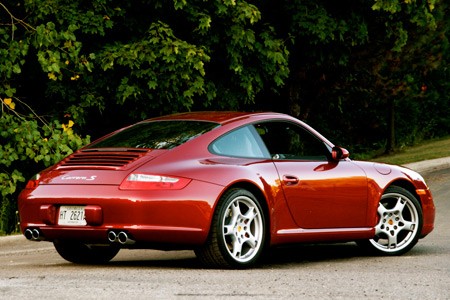
The 911 has long been offered in a variety of configurations to suit various tastes and budgets (although all are elevated to some degree). With a coupe, targa and convertible powered by normally aspirated and turbocharged engines from which to choose, we received a Ruby Red Carrera S. The non-turbo flat-6 engine in the S gets a bump in displacement from 3.6L to 3.8L overs its non-S counterpart with a commensurate increase in power from 325 to 355 hp, while torque goes from 273 to 295 lb-ft. Way back in the 1970s when the original 911 Turbo (also known as the 930) debuted, it was considered a beast, although back then it made a mere 256 hp, nearly one third less than today's S.
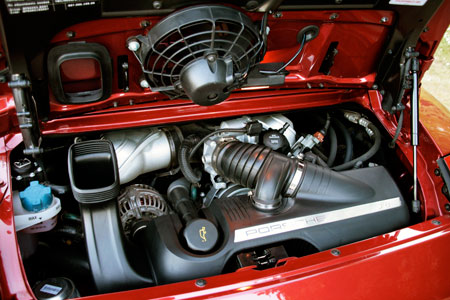
Anyone who has ever laid eyes on a 911 will immediately recognize the latest model. Although the shape has been stretched a bit, the headlights swept back and everything slicked down to reduce drag, the basic look remains. The classic 911 greenhouse is the giveaway along with the back end that slopes down over the rear-mounted engine to the back bumper. Interestingly, we found that comparing dimensions between the 911 and potential rivals such as the Audi R8 and Chevrolet Corvette, reveals that all three are nearly identical in length with only 0.3 inches separating the longest from the shortest. The Audi R8, however, is two inches wider and the 911 two inches taller.
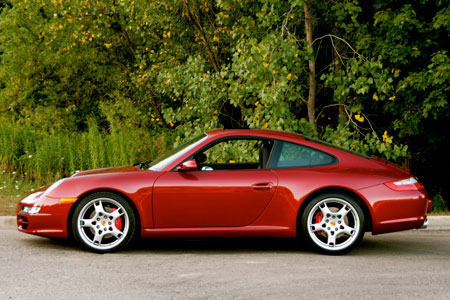
There is, however, one dimension that differs radically: wheelbase. The 911 Carrera S spans 92.5 inches between the axles while the R8 goes on for 104.3 inches and the Vette reaches all the way to 105.7 inches. In spite of their similar lengths, the Carrera feels substantially smaller than the other two cars. One sits low in all three, but the Audi and Chevy give an impression of great mass. In the Porsche, the corners of the car both literally and visually just fall away. Combined with slim pillars all around, the 911 has some of the best outward visibility available in any car of any class.
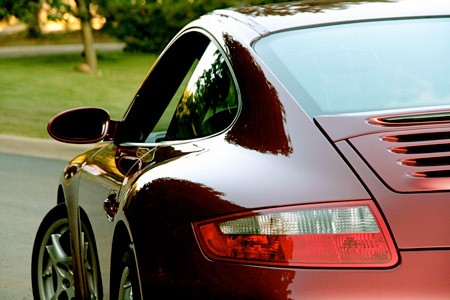
Driving around town in the Audi or Chevrolet can be a nerve wracking experience because of their huge blind spots. The 911 seems shrink-wrapped around you and nothing appears able to hide from view. The 911 has long been described as a sports car that can be used as a daily driver and to a large extent this is true. The Carrera does sit lower than most mainstream cars, but ingress and egress is still a snap. In typical German fashion, the interior is beautifully finished with cut and sew leather covering the dash and top of the door panels, and the suede headliner is a cut above what you typically find.
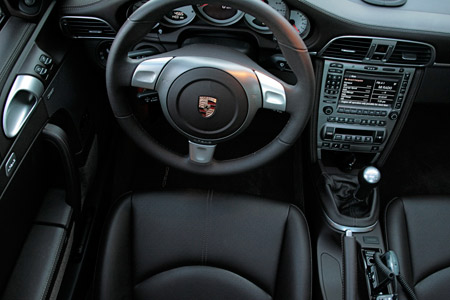
The sensation of compact dimensions is further reinforced by the closeness of the dashboard and the windshield. Unlike other cars with steeply raked windshields where the base seems out somewhere near the front bumper, the Carrera windshield is more upright. There are also touches inside that are decidedly peculiar. While virtually the entire automotive world locates the key (or start button in many modern cases) to the right of the steering column, Porsche keeps the 911 ignition on the left. The power window switches also sit up high on the door panel ahead of the latch, and the switches themselves are simple up/down rockers rather than the newer horizontally mounted safety switches that have to be pulled up to raise the window.
We can't complain about another inscrutable German navigation system since Porsche didn't install the map DVDs, nor even enable the satellite radio. This particular model was not optioned with Porsche's navigation system and satellite radio was just made available on all models for the 2009 model year, before which it was only available on the Cayenne. Still, the audio system doesn't have an auxiliary input for mp3 players, so bring your CDs. Amazingly, the 911 does have cup holders, but they are hidden behind a slim metal panel just above the glove box. Of course, none of that really matters. Contrary to the image one gets from many Porsche owners who are clearly poseurs, the 911 is built for driving.
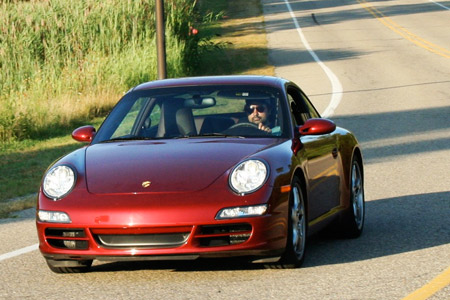
One might expect a comparatively small displacement 3.8L six cylinder to be high strung and hard to drive around town, but nothing could be further from the truth. Having recently driven several cars with larger displacement V8s, this is an entirely different animal. There is none of the rumble and low frequency pulsing that you get in a V8. Rather, the six is perfectly smooth and balanced and the sound of the Porsche boxer is unlike almost anything else on the road. It has a mechanical, almost turbine-like sound that builds in intensity as the tach needle rotates clock-wise. The numbers may not indicate a particularly strong engine at the bottom end, but there is a surprisingly fat torque curve. No, it doesn't generate the kind of thrust you get from a Vette, but it just pulls insistently.
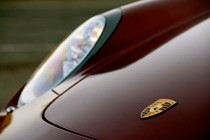
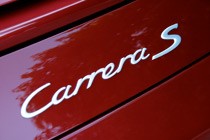
One of the prime areas of continual improvement over the last four and a half decades has been the 911's handling. While hanging the flat-6 out behind the rear axle provides certain packaging advantages compared to a mid-engine layout, the weight distribution can make handling dynamics tricky to say the least. Throughout the existence of the air-cooled 911, Porsche was constantly tweaking the suspension to make it more manageable for less than expert drivers, but the advent of the water-cooled 996 a decade ago largely tamed the dynamics of the Carrera. The car still understeers, but breakaway is far more manageable when approaching the limits of adhesion.
That rear weight bias does help a lot, however, in longitudinal acceleration. By putting more of the car's mass over its drive wheels, more grip is available when taking off. Even with transferring to the front under hard braking, the 911 has more normal force pushing down on its rear tires, which allows the rear brakes to do more of the work. Even without the extremely expensive optional carbon-ceramic brakes, the 911's cross-drilled steel rotors and big four pot calipers can dissipate kinetic energy in a hurry.
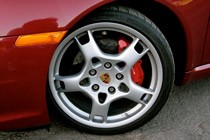
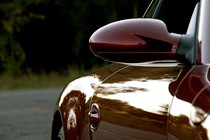
The steering of the 911 is one characteristic that's been praised over the years, and rightfully so. The steering wheel is very upright in the 911 and adjustable both vertically and longitudinally. Feedback through the wheel when cornering is among the best you'll find anywhere. The action of the gear shift lever is equally precise and feels like you're stirring the 6-speed gearbox directly.
The only fly in the ointment is some overly long clutch pedal travel. Unlike the Corvette ZR1 we drove recently, which had a nice balance of travel between the three pedals, the Carrera's clutch travel is much longer than the brake or accelerator. It's not clear if this is common to all rear-drive 911s or just this example. This is perhaps the only element of the driving experience that would detract from using the Carrera as a daily driver.
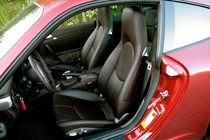
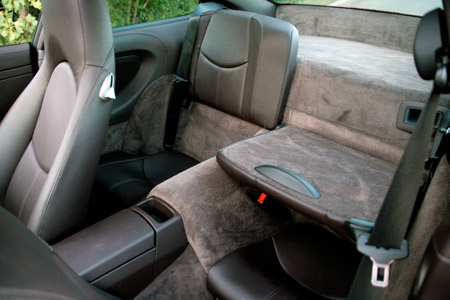
The rear engine layout does allow the 911 to have rear seats, although these are strictly of the +2 variety. The second row of a Carrera is best considered a large storage space, unless you have friends that are hinged in the middle. Rear-drive Carreras like our tester also offer a very usefully shaped trunk up front. The capacity is only 4.4 cu. ft., but it can easily accommodate a couple of small bags or a few bags of groceries.
The Carrera S certainly isn't cheap with a starting price of $83,800, and Porsche has long offered owners the ability to customize their cars up to stratospheric price levels. Our particular example came in at $96,655 thanks to a $2,400 sport exhaust system and $3,795 Cocoa leather package. There are certainly faster cars available at this price, but not many offer the pedigree of a Porsche and can replace a lesser car as your daily driver.
Photos Copyright ©2008 Sam Abuelsamid / Weblogs, Inc.

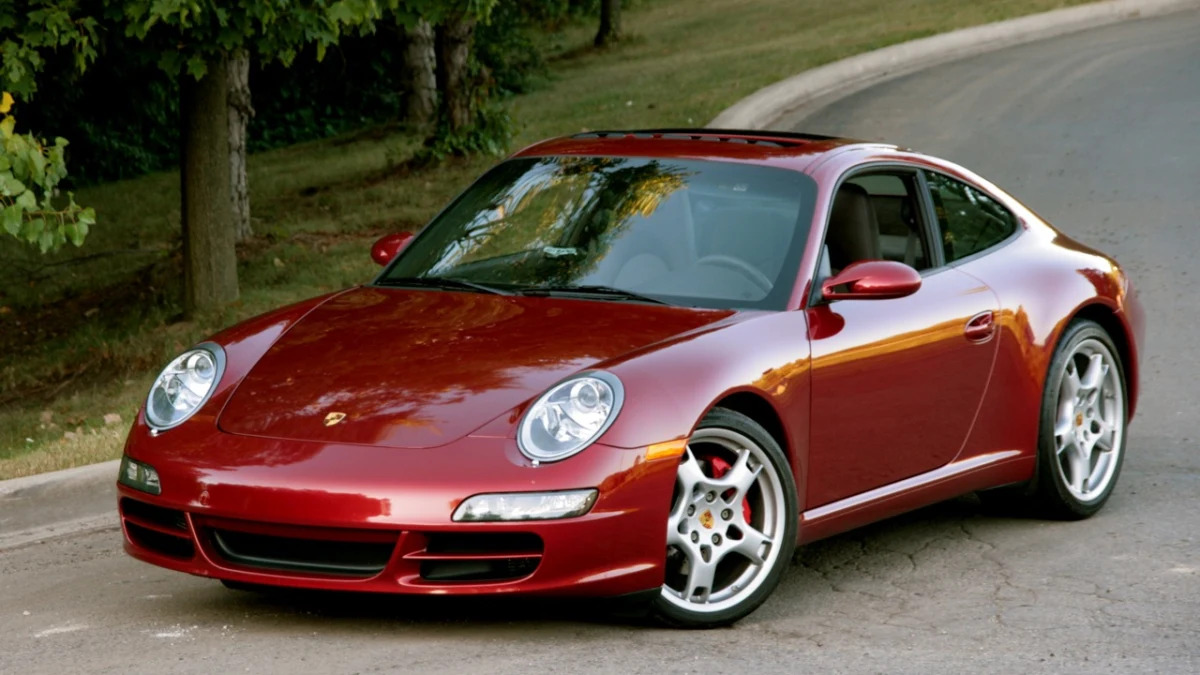

Sign in to post
Please sign in to leave a comment.
Continue